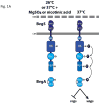Bordetella pertussis pathogenesis: current and future challenges
- PMID: 24608338
- PMCID: PMC4205565
- DOI: 10.1038/nrmicro3235
Bordetella pertussis pathogenesis: current and future challenges
Abstract
Pertussis, also known as whooping cough, has recently re-emerged as a major public health threat despite high levels of vaccination against the aetiological agent Bordetella pertussis. In this Review, we describe the pathogenesis of this disease, with a focus on recent mechanistic insights into B. pertussis virulence-factor function. We also discuss the changing epidemiology of pertussis and the challenges facing vaccine development. Despite decades of research, many aspects of B. pertussis physiology and pathogenesis remain poorly understood. We highlight knowledge gaps that must be addressed to develop improved vaccines and therapeutic strategies.
Conflict of interest statement
The authors declare no competing interests.
Figures




References
-
- de Greeff SC, et al. Pertussis disease burden in the household: how to protect young infants. Clin Infect Dis. 2010;50:1339–45. - PubMed
-
- Bordet J, Gengou O. Le microbe de la coqueluche. Annales de I’Institut Pasteur. 1906;20:731–741.
-
- Cherry JD. Why do pertussis vaccines fail? Pediatrics. 2012;129:968–70. - PubMed
-
- Diavatopoulos DA, et al. Bordetella pertussis, the causative agent of whooping cough, evolved from a distinct, human-associated lineage of B. bronchiseptica. PLoS Pathog. 2005;1:e45. This study identified four complexes of Bordetella and suggested that B. pertussis and B. parapertussis independently evolved from a B. bronchiseptica-like ancestor. - PMC - PubMed
Publication types
MeSH terms
Substances
Grants and funding
LinkOut - more resources
Full Text Sources
Other Literature Sources
Medical

